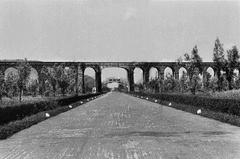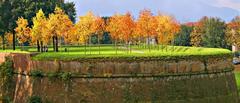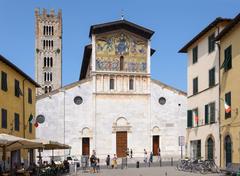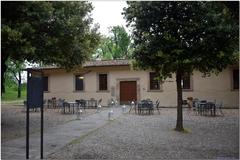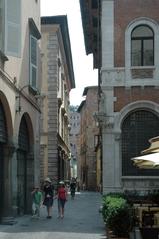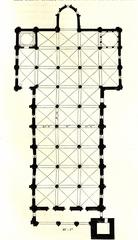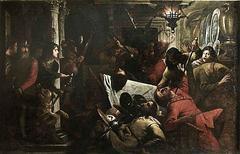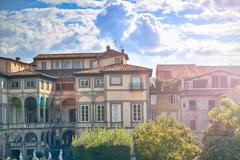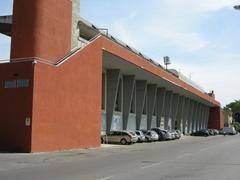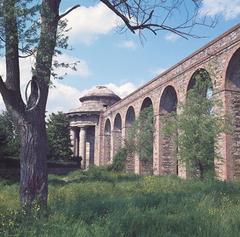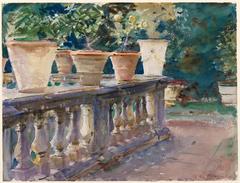Fontana della Naiade Lucca Visiting Hours, Tickets, and Travel Guide
Date: 14/06/2025
Introduction
Nestled in the heart of Lucca’s historic center, the Fontana della Naiade—affectionately known as “La Pupporona”—stands as a striking emblem of the city’s 19th-century artistic renewal and civic pride. Commissioned during a transformative period of urban modernization, this neoclassical fountain harmoniously blends mythological symbolism, public utility, and sculptural excellence. Today, it serves not only as a beloved gathering spot in Piazza San Salvatore but also as an enduring testament to Lucca’s cultural and architectural heritage (Welcome2Lucca, ItalyScapes, Progetto Storia dell’Arte).
This detailed guide covers the fountain’s artistic conception, historical context, visitor information, and practical travel tips to ensure a rewarding visit to this iconic Lucca landmark.
Table of Contents
- Introduction
- Historical Background
- Artistic and Cultural Significance
- Architectural Features
- Location and Surroundings
- Visitor Information
- Cultural Insights and Anecdotes
- Nearby Attractions
- Travel Tips for Visitors
- Frequently Asked Questions (FAQs)
- Visuals and Media
- Conclusion
- References
Historical Background
The Fontana della Naiade, or “La Pupporona,” was commissioned during the early 19th century as part of a broader initiative to modernize Lucca’s water infrastructure. The project was spearheaded by architect and engineer Lorenzo Nottolini, renowned for his contributions to the city’s aqueducts and public works (Welcome2Lucca). Construction began in 1835–36 and concluded around 1840. The marble Naiad statue was sculpted by Luigi Camolli—though some sources credit Ferdinando Fontana—following Nottolini’s design (Two Parts Italy).
The fountain was directly supplied by the monumental Nottolini Aqueduct, channeling fresh water from the Monti Pisani hills. This not only enhanced public health by replacing open wells and canals but also enriched Lucca’s urban landscape with a new artistic focal point (Welcome2Lucca).
Artistic and Cultural Significance
Neoclassical Ideals and the Naiad Motif
The Fontana della Naiade exemplifies the neoclassical revival of mythological themes in public art. The Naiad, a graceful water nymph from Greek tradition, symbolizes purity, healing, and the vital role of water in civic life. Her pose, inspired by the “Venere Pudica” (Modest Venus) type, recalls ancient Roman models and communicates both modesty and vitality (Progetto Storia dell’Arte).
The fountain’s artistic execution reflects the purist movement’s blend of classical form and naturalistic detail. The Naiad’s partially exposed torso and flowing drapery—evoking the “wet drapery” effect—generated controversy at the time, especially given the fountain’s proximity to a church, but ultimately became a cherished local emblem (Two Parts Italy).
Symbolism and Community Resonance
The fountain’s sculptural details, including the amphora and lion motifs, reinforce themes of life-giving water, strength, and guardianship. Over the decades, the Naiad has become a symbol of local identity and communal spirit, featuring in public campaigns, celebrations, and everyday life (Welcome2Lucca).
Architectural Features
Materials and Structure
The fountain is crafted from local marble, selected for its durability and aesthetic harmony with Lucca’s historic buildings. A cubical pedestal supports the statue, while an elongated marble basin, adorned with sculpted lion paws and heads, symbolizes classical and heraldic traditions. The fountain is encircled by a low iron railing connected to marble posts—a practical measure to protect it from past carriage traffic (Welcome2Lucca).
Water Features
Water flows from three jets: a central lion head at the Naiad’s base and two lateral spigots, each emptying into smaller basins. Supplied directly by the Nottolini Aqueduct, the water is renowned for its clarity and taste (Two Parts Italy).
Location and Surroundings
Fontana della Naiade is centrally located in Piazza San Salvatore, a charming square just steps from Piazza San Michele and the Church of San Michele in Foro (ItalyScapes). The piazza is ringed by notable buildings, including the ochre-colored Church of San Salvatore (Chiesa della Misericordia), Renaissance Palazzo Cenami, and medieval Torre Del Veglio, creating a harmonious architectural setting.
Visitor Information
Visiting Hours
The fountain is accessible 24 hours a day, year-round, as it sits in a public piazza. There are no barriers or restricted hours.
Ticket Information
Admission is free; no tickets are required to visit or enjoy the fountain.
Getting There
Piazza San Salvatore is about one kilometer from Lucca’s main railway station and can be easily reached on foot or by bicycle. The LAM Verde bus line stops nearby, and the city’s pedestrian-friendly layout makes navigation straightforward (GoAskALocal).
Accessibility
The square is flat and paved, offering good accessibility for visitors with mobility challenges. The low fence surrounding the fountain allows close viewing and easy access to the water spigots.
Drinking Water
The fountain dispenses clean, potable water from the Nottolini Aqueduct, favored by locals for its freshness. Many visitors fill their water bottles here, and some claim each spigot has a subtly different taste (Two Parts Italy).
Maintenance and Cleanliness
The fountain benefits from regular maintenance and periodic restoration, most recently supported by the Rotary Club. While algae or debris may appear in the basin, the water from the spigots remains clean and safe (Cronaca di Lucca, NoiTV).
Cultural Insights and Anecdotes
The Naiad’s partial nudity once sparked outcry from the local bishop, who unsuccessfully campaigned for the statue’s removal. Over time, “La Pupporona” became a term of endearment, and the piazza itself is often called by this nickname. The fountain is sometimes decorated for local events, including campaigns against domestic violence, when the statue is adorned with a red scarf (Two Parts Italy).
Nearby Attractions
After admiring the fountain, visitors can explore:
- Piazza San Michele and the Church of San Michele in Foro
- Piazza dell’Anfiteatro
- Guinigi Tower
- Puccini Museum
- Via Fillungo, the main shopping street (ItalyScapes)
Travel Tips for Visitors
- Best times to visit: Early morning and late afternoon provide the best lighting for photography.
- Bring a reusable bottle: Enjoy fresh aqueduct water straight from the fountain.
- Respect local customs: Please do not climb or sit on the sculpture.
- Local insights: Engage with residents to learn more about the fountain’s history and significance.
Frequently Asked Questions (FAQs)
Q: What are the fountain’s visiting hours?
A: The fountain is accessible all day, every day.
Q: Is there an entrance fee?
A: No, it is free to visit.
Q: Is the water safe to drink?
A: Yes, the water is clean and potable.
Q: Is the fountain accessible for visitors with disabilities?
A: Yes, the piazza is flat and wheelchair-friendly.
Q: Are guided tours available?
A: Many city tours include Piazza San Salvatore and the fountain.
Q: What other attractions are nearby?
A: Piazza San Michele, Piazza dell’Anfiteatro, Guinigi Tower, and more.
Visuals and Media

Alt tag: Fontana della Naiade in Lucca showcasing neoclassical naiads sculpture
Alt tag: Map highlighting the Fontana della Naiade location in Lucca city center
For additional images and virtual tours, visit Progetto Storia dell’Arte.
Conclusion
The Fontana della Naiade is a testament to Lucca’s artistic heritage, civic ingenuity, and communal identity. Its neoclassical elegance, storied past, and ongoing role as a living monument make it a must-see for any visitor to Tuscany. Whether you’re appreciating its sculptural beauty, sipping its renowned water, or learning about its cultural resonance, the fountain offers a memorable experience that bridges Lucca’s past and present.
For more information on Lucca’s history and travel tips, explore further resources below and consider including the fountain as a highlight on your next visit.
References and Further Reading
- Lacqua a Lucca, 2022, Welcome2Lucca
- Piazza San Salvatore - Fontana della Naiade, 2022, ItalyScapes
- La Fontana delle Naiadi di Luigi Pampaloni, 2021, Progetto Storia dell’Arte
- A Fountain of Beauty in Lucca, 2022, Two Parts Italy
- Empoli Torna a Zampillare la Fontana delle Naiadi, 2020, QuiNewsempolese
- Travel Guide to Lucca Italy, 2021, GoAskALocal
- Intervento di Ripulitura per la Pupporona, 2020, NoiTV
- La Fontana della Naiade o della Pupporona, 2020, Cronaca di Lucca
